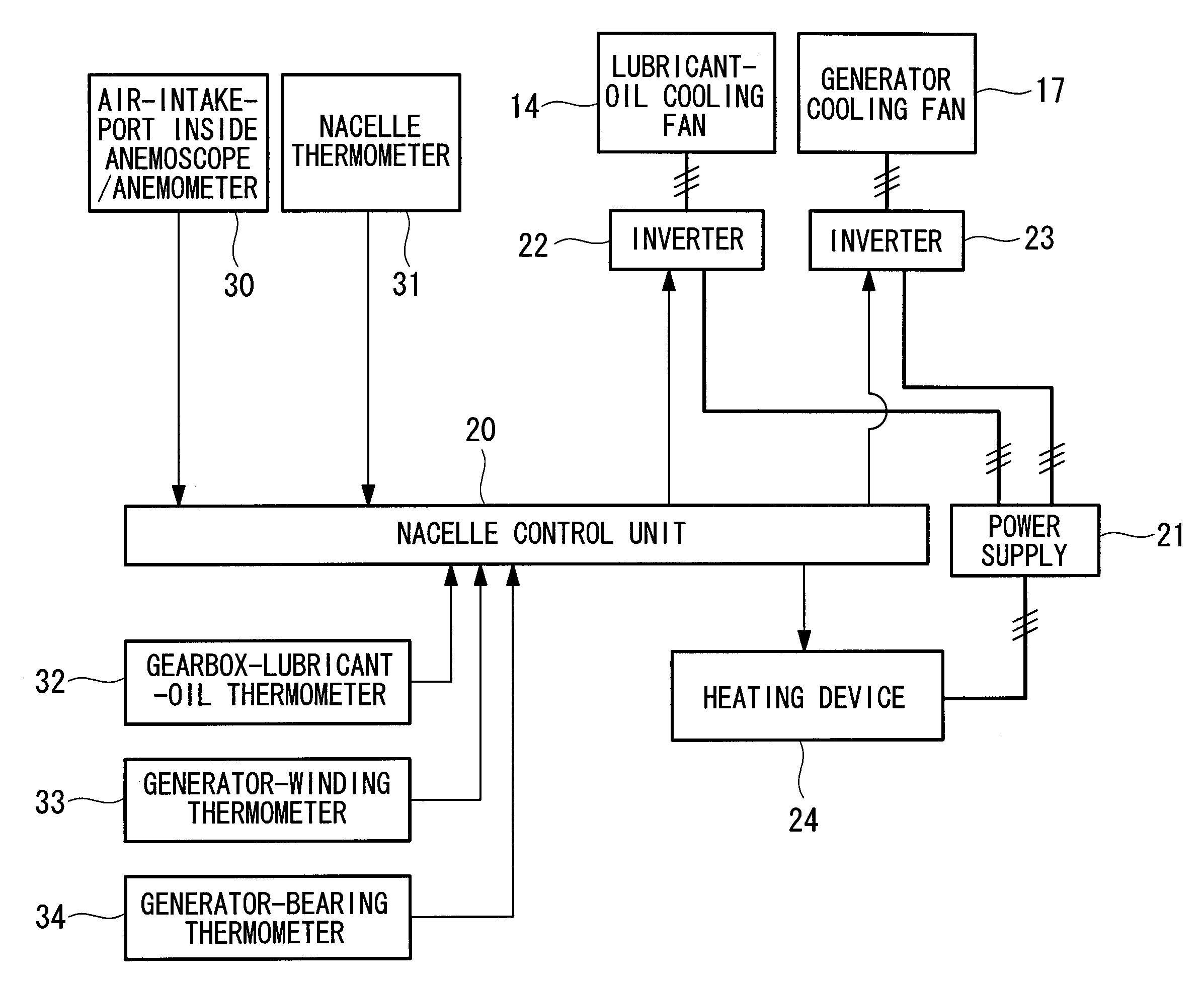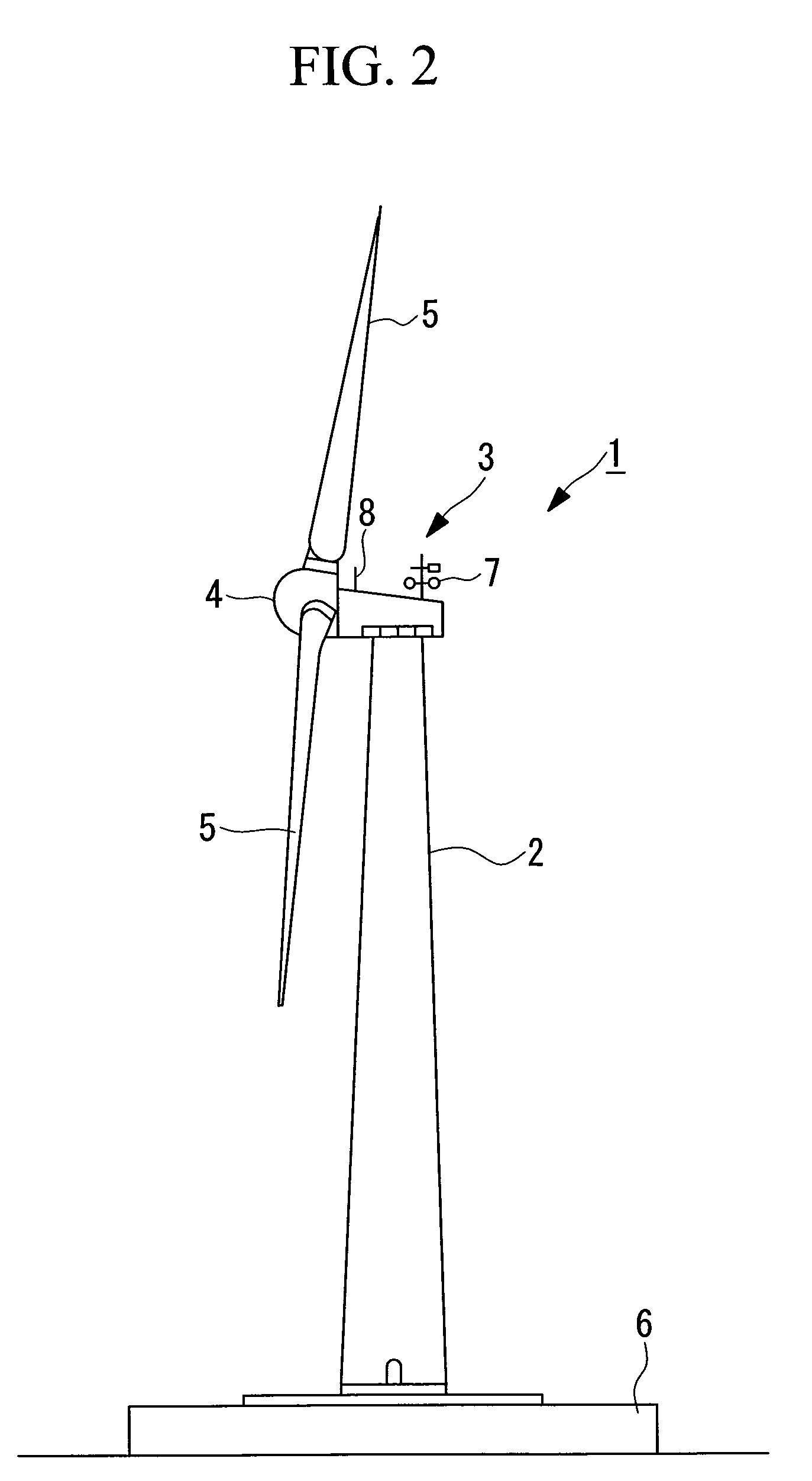Wind turbine generator
a wind turbine generator and wind turbine technology, applied in the direction of electric generator control, machines/engines, rotors, etc., can solve the problems of reducing the temperature of the nacelle interior that is heated, affecting the heating efficiency of the nacelle, and seized opening and closing mechanisms, etc., to achieve efficient heating of the nacelle interior
- Summary
- Abstract
- Description
- Claims
- Application Information
AI Technical Summary
Benefits of technology
Problems solved by technology
Method used
Image
Examples
first embodiment
[0054]In a first embodiment, the nacelle closing mechanism which prevents or reduces entry of outside air into the nacelle 3 by controlling the rotating direction and rotational speed of a cooling ventilating fan provided at the nacelle 3 of the wind turbine generator 1 will be described.
[0055]As shown in FIG. 3, for example, the nacelle 3 accommodates a driving and generating mechanism equipped with a generator 11 that is connected to the rotor head 4 via a gearbox 10. That is, generator output power W is obtained from the generator 11 by driving the generator 11 while increasing the rotational speed of the rotor head 4 with the gearbox 10.
[0056]The above-described nacelle 3 has a ventilating and cooling device that circulates introduced outside air therethrough and thereafter exhausts it to the outside of the nacelle so as to prevent an internal temperature rise during operation.
[0057]In the configuration example of the ventilating and cooling device shown in FIG. 3, an air intake...
second embodiment
[0077]A second embodiment of the present invention will be described with reference to FIGS. 5 to 8. The same components as those in the foregoing embodiment are given the same reference numerals and detailed descriptions thereof will be omitted.
[0078]In this embodiment, a bag-like inflating and deflating member connected to a compressed-fluid supply part is provided, as a nacelle closing mechanism, at the air intake port 12, which is one of the ventilation ports. The inflating and deflating member in this case is a balloon 40, which closes the air intake port 12 by means of the balloon shape during inflation upon receiving the compressed air supplied from an intake-air shutoff compressor 41 of the compressed-fluid supply part and which opens the air intake port 12 during deflation upon releasing the compressed air.
[0079]As shown in FIGS. 7A and 7B, for example, the balloon 40 is accommodated in a cover member 40a that defines the shape during inflation. It is preferable not only th...
third embodiment
[0085]A third embodiment of the present invention will be described with reference to FIG. 9. The same components as those in the foregoing embodiments are given the same reference numerals and detailed descriptions thereof will be omitted.
[0086]In this embodiment, as a nacelle closing mechanism, the ventilation port is closed by means of the flow of compressed fluid. That is, it has a configuration and control in which the balloon 40 in the second embodiment described above is changed to an air curtain nozzle 50, in which, instead of inflating the balloon 40, compressed air is made to flow out through the air curtain nozzle 50 to form an air curtain, and instead of deflating the balloon 40, the supply of the compressed air to the air curtain is stopped.
[0087]With such a configuration and control, when the air curtain, which is a flow of compressed air, is formed, the air intake port 12 becomes closed, and when no air curtain is formed, the air intake port 12 becomes opened. Accordi...
PUM
 Login to View More
Login to View More Abstract
Description
Claims
Application Information
 Login to View More
Login to View More - R&D
- Intellectual Property
- Life Sciences
- Materials
- Tech Scout
- Unparalleled Data Quality
- Higher Quality Content
- 60% Fewer Hallucinations
Browse by: Latest US Patents, China's latest patents, Technical Efficacy Thesaurus, Application Domain, Technology Topic, Popular Technical Reports.
© 2025 PatSnap. All rights reserved.Legal|Privacy policy|Modern Slavery Act Transparency Statement|Sitemap|About US| Contact US: help@patsnap.com



